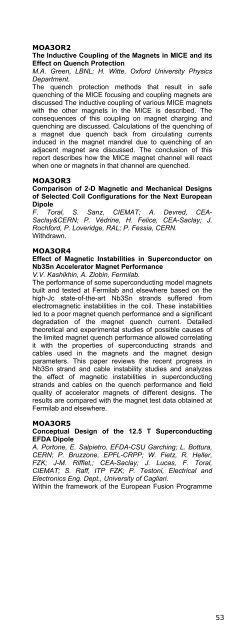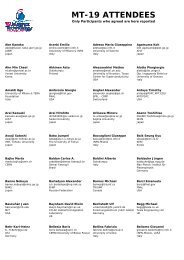Click here to download the abstract booklet in pdf format - MT19 - Infn
Click here to download the abstract booklet in pdf format - MT19 - Infn
Click here to download the abstract booklet in pdf format - MT19 - Infn
You also want an ePaper? Increase the reach of your titles
YUMPU automatically turns print PDFs into web optimized ePapers that Google loves.
MOA3OR2<br />
The Inductive Coupl<strong>in</strong>g of <strong>the</strong> Magnets <strong>in</strong> MICE and its<br />
Effect on Quench Protection<br />
M.A. Green, LBNL; H. Witte, Oxford University Physics<br />
Department.<br />
The quench protection methods that result <strong>in</strong> safe<br />
quench<strong>in</strong>g of <strong>the</strong> MICE focus<strong>in</strong>g and coupl<strong>in</strong>g magnets are<br />
discussed The <strong>in</strong>ductive coupl<strong>in</strong>g of various MICE magnets<br />
with <strong>the</strong> o<strong>the</strong>r magnets <strong>in</strong> <strong>the</strong> MICE is described. The<br />
consequences of this coupl<strong>in</strong>g on magnet charg<strong>in</strong>g and<br />
quench<strong>in</strong>g are discussed. Calculations of <strong>the</strong> quench<strong>in</strong>g of<br />
a magnet due quench back from circulat<strong>in</strong>g currents<br />
<strong>in</strong>duced <strong>in</strong> <strong>the</strong> magnet mandrel due <strong>to</strong> quench<strong>in</strong>g of an<br />
adjacent magnet are discussed. The conclusion of this<br />
report describes how <strong>the</strong> MICE magnet channel will react<br />
when one or magnets <strong>in</strong> that channel are quenched.<br />
MOA3OR3<br />
Comparison of 2-D Magnetic and Mechanical Designs<br />
of Selected Coil Configurations for <strong>the</strong> Next European<br />
Dipole<br />
F. Toral, S. Sanz, CIEMAT; A. Devred, CEA-<br />
Saclay&CERN; P. Védr<strong>in</strong>e, H. Felice, CEA-Saclay; J.<br />
Rochford, P. Loveridge, RAL; P. Fessia, CERN.<br />
Withdrawn.<br />
MOA3OR4<br />
Effect of Magnetic Instabilities <strong>in</strong> Superconduc<strong>to</strong>r on<br />
Nb3Sn Accelera<strong>to</strong>r Magnet Performance<br />
V.V. Kashikh<strong>in</strong>, A. Zlob<strong>in</strong>, Fermilab.<br />
The performance of some superconduct<strong>in</strong>g model magnets<br />
built and tested at Fermilab and elsew<strong>here</strong> based on <strong>the</strong><br />
high-Jc state-of-<strong>the</strong>-art Nb3Sn strands suffered from<br />
electromagnetic <strong>in</strong>stabilities <strong>in</strong> <strong>the</strong> coil. These <strong>in</strong>stabilities<br />
led <strong>to</strong> a poor magnet quench performance and a significant<br />
degradation of <strong>the</strong> magnet quench current. Detailed<br />
<strong>the</strong>oretical and experimental studies of possible causes of<br />
<strong>the</strong> limited magnet quench performance allowed correlat<strong>in</strong>g<br />
it with <strong>the</strong> properties of superconduct<strong>in</strong>g strands and<br />
cables used <strong>in</strong> <strong>the</strong> magnets and <strong>the</strong> magnet design<br />
parameters. This paper reviews <strong>the</strong> recent progress <strong>in</strong><br />
Nb3Sn strand and cable <strong>in</strong>stability studies and analyzes<br />
<strong>the</strong> effect of magnetic <strong>in</strong>stabilities <strong>in</strong> superconduct<strong>in</strong>g<br />
strands and cables on <strong>the</strong> quench performance and field<br />
quality of accelera<strong>to</strong>r magnets of different designs. The<br />
results are compared with <strong>the</strong> magnet test data obta<strong>in</strong>ed at<br />
Fermilab and elsew<strong>here</strong>.<br />
MOA3OR5<br />
Conceptual Design of <strong>the</strong> 12.5 T Superconduct<strong>in</strong>g<br />
EFDA Dipole<br />
A. Por<strong>to</strong>ne, E. Salpietro, EFDA-CSU Garch<strong>in</strong>g; L. Bottura,<br />
CERN; P. Bruzzone, EPFL-CRPP; W. Fietz, R. Heller,<br />
FZK; J-M. Rifflet,; CEA-Saclay; J. Lucas, F. Toral,<br />
CIEMAT; S. Raff, ITP FZK; P. Tes<strong>to</strong>ni, Electrical and<br />
Electronics Eng. Dept., University of Cagliari.<br />
With<strong>in</strong> <strong>the</strong> framework of <strong>the</strong> European Fusion Programme<br />
a design activity has been started <strong>in</strong> late 2004 by <strong>the</strong> EFDA<br />
Close Support Unit at Garch<strong>in</strong>g (FRG) <strong>to</strong> design a 12.5 T<br />
superconduct<strong>in</strong>g dipole magnet. The f<strong>in</strong>al goal of this<br />
activity is <strong>to</strong> def<strong>in</strong>e a “m<strong>in</strong>imum cost” and “m<strong>in</strong>imum risk”<br />
dipole <strong>to</strong> be built with<strong>in</strong> <strong>the</strong> next 3 years by European<br />
<strong>in</strong>dustries. The newly built magnet shall be hosted <strong>in</strong> one of<br />
<strong>the</strong> exist<strong>in</strong>g cryogenic labora<strong>to</strong>ries <strong>in</strong> <strong>the</strong> EU <strong>to</strong> test, <strong>in</strong><br />
particular, <strong>the</strong> full size conduc<strong>to</strong>r samples that shall be<br />
produced dur<strong>in</strong>g <strong>the</strong> ITER magnets procurement. As a<br />
result of this study - carried out <strong>in</strong> cooperation with several<br />
European labora<strong>to</strong>ries - different concepts have been<br />
analysed and optimised. All designs are based on <strong>the</strong> use<br />
of high current density Nb3Sn strands (~ 2000 A/mm2 at<br />
12 T/4.2 K). It is assumed that <strong>the</strong>se strands can be cabled<br />
ei<strong>the</strong>r as Cable In Conduit Conduc<strong>to</strong>rs (CICC) or as<br />
Ru<strong>the</strong>rford-type Cables (RC) and <strong>the</strong>n wound as planar<br />
racetrack, non-planar (saddle) or cosq coils. The aim of this<br />
paper is <strong>to</strong> provide an overview of this study activity with<br />
particular emphasis <strong>to</strong> <strong>the</strong> optimisation steps followed <strong>in</strong><br />
<strong>the</strong> design of each magnet concept. Four different types<br />
are described: a planar CICC/RC-based coil, a saddle<br />
CICC-based coil and a cosq RC-based coil. Each design is<br />
described <strong>to</strong>ge<strong>the</strong>r with <strong>the</strong> salient optimization steps that<br />
<strong>in</strong>clude electromagnetic, structure mechanic and <strong>the</strong>rmohydraulic<br />
analyses as well as different manufactur<strong>in</strong>g<br />
constra<strong>in</strong>ts.<br />
MOA3OR6<br />
Permanent Cyclotron Magnet<br />
E. An<strong>to</strong>kh<strong>in</strong>, M. Kumada, JST/NIRS; S. Wasaka, AEC; T.<br />
Fujisawa, NIRS; Y. Iwashita, ICR Kyo<strong>to</strong> University; S.<br />
Matsumoo, AEC/Dokkyo University; Y. Matsuda, Osaka<br />
Pref. University; I. Bolshakova, R. Holyaka, V. Erashok,<br />
MSL.<br />
Magnet for circular accelera<strong>to</strong>r can be made as copper<br />
normal conduct<strong>in</strong>g electromagnet or superconduct<strong>in</strong>g<br />
magnet. The application of permanent magnet <strong>to</strong> <strong>the</strong><br />
accelera<strong>to</strong>r <strong>in</strong> <strong>the</strong> past, however, was only a s<strong>to</strong>rage r<strong>in</strong>g of<br />
anti-pro<strong>to</strong>n at Fermilab. Here <strong>in</strong> this article we will report on<br />
a design, construction and field quality of a permanent<br />
magnet for a cyclotron application which can be used as a<br />
iso<strong>to</strong>pe production such as FDG <strong>in</strong> Positron Emission<br />
Tomography, s well as an <strong>in</strong>jec<strong>to</strong>r of a cascaded<br />
accelera<strong>to</strong>r complex. The design energy of <strong>the</strong> cyclotron is<br />
10 MeV. Due <strong>to</strong> an <strong>in</strong>genious configuration of magnetic<br />
circuit structure, a field strength can be varied from a 2.3 T<br />
maximum field <strong>to</strong> zero. The built <strong>in</strong> switch<strong>in</strong>g off capability<br />
of <strong>the</strong> magnetic field can make a field distribution<br />
adjustment <strong>to</strong> get isochronous field easier. In order <strong>to</strong> make<br />
a field mapp<strong>in</strong>g of <strong>the</strong> cyclotron magnet fur<strong>the</strong>r efficient, a<br />
very accurate field mapper of 48 sensors were specially<br />
developed w<strong>here</strong> a complete mapp<strong>in</strong>g of <strong>the</strong> magnet can<br />
be done <strong>in</strong> 3 hours. Interleav<strong>in</strong>g of particle track<strong>in</strong>g and<br />
field shimm<strong>in</strong>g was done extensively. Temperature<br />
dependence was studied carefully. All of <strong>the</strong>se details will<br />
be presented <strong>in</strong> <strong>the</strong> article.<br />
53 MT-19 2005, Genova



